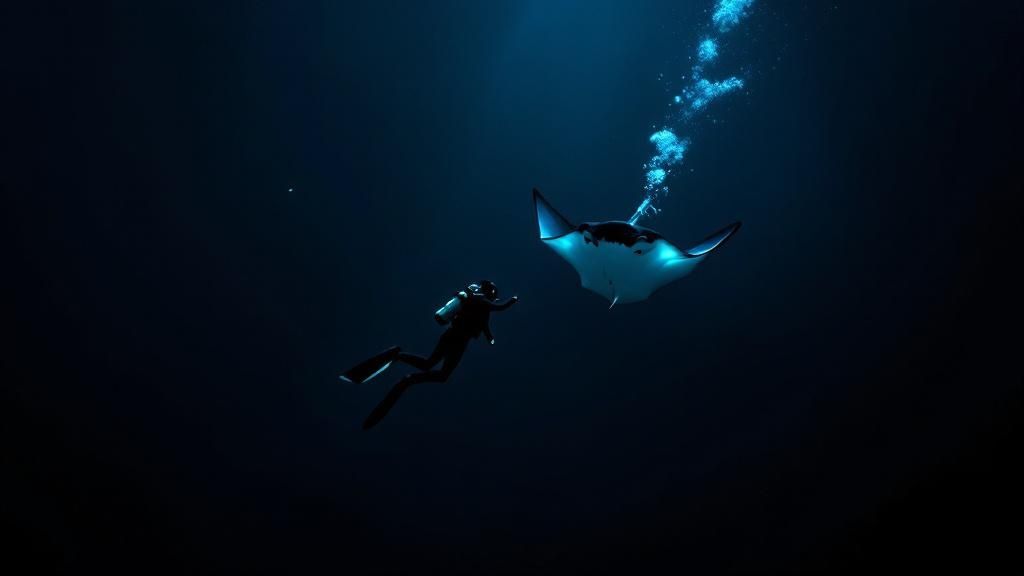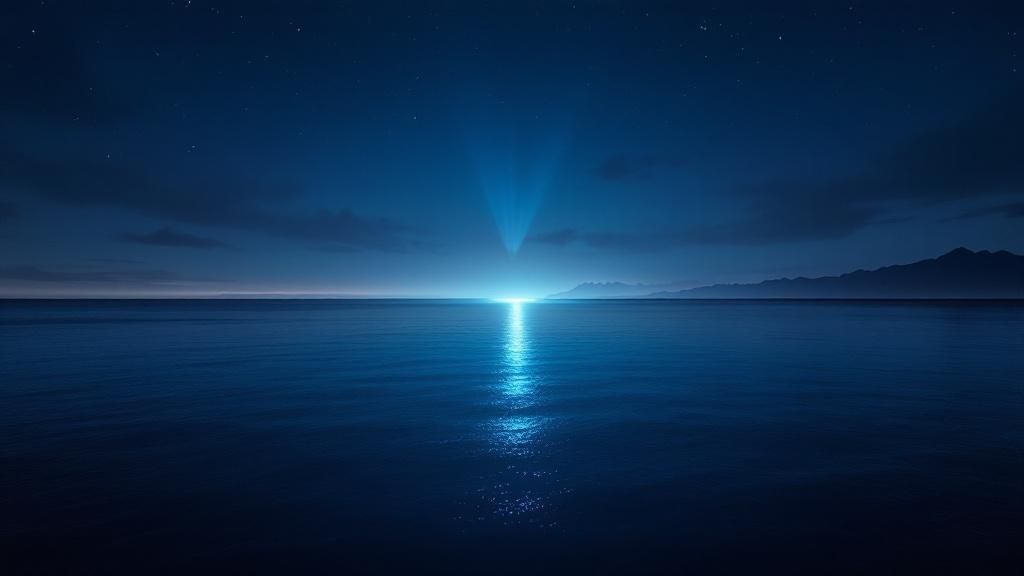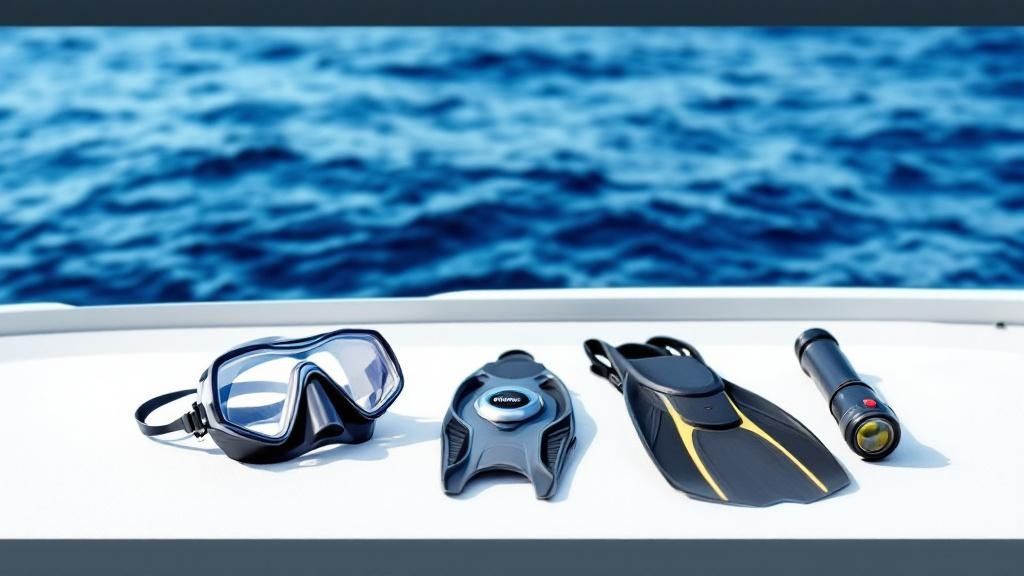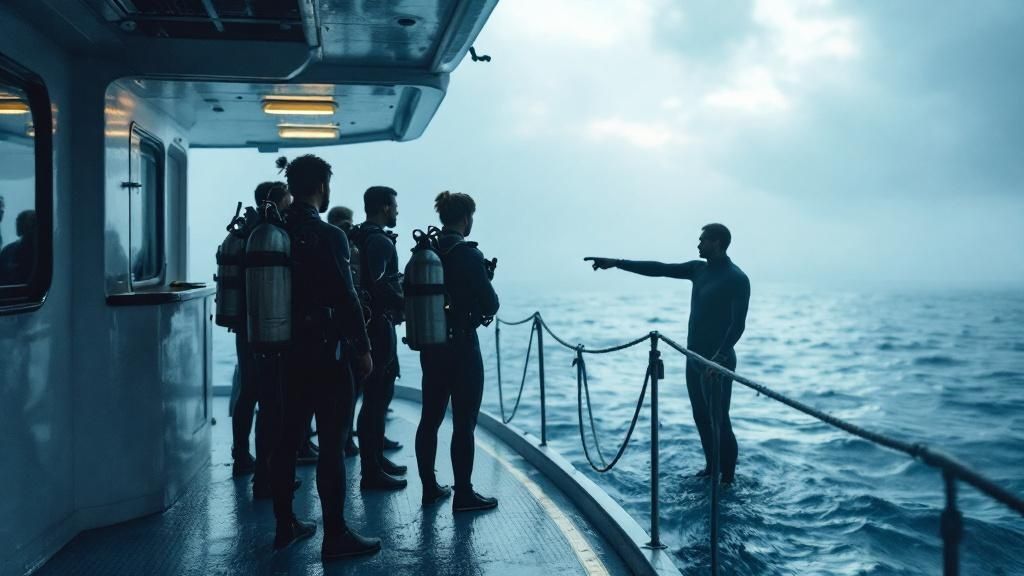Picture this: you're sinking into the warm Hawaiian ocean as dusk settles, finding your spot on the sandy bottom.Suddenly, graceful giants with wingspans wider than a car are gliding just inches above your head. This isn't something you watch on a nature show—it's the world-famous manta ray dive in Kona, an experience so consistently incredible it’s a bucket-list item for ocean lovers around the globe.
Welcome to the World-Famous Kona Manta Ray Dive

The Kona coast of the Big Island is more than just another stunning Hawaiian location; it’s a world-renowned stage for one of the most mesmerizing ballets in the natural world. The setup is brilliantly simple. You head out on a boat just before sunset and get in the water as darkness falls. Divers find a spot on the ocean floor, while snorkelers hang onto a custom floating light board. Everyone points their powerful lights up, creating columns of light in the water.
This light show attracts a massive cloud of plankton, which happens to be the manta rays' favorite food. Before long, the stars of the show arrive. With incredible grace, these gentle giants swoop, glide, and barrel roll through the light beams, feasting on the plankton buffet and often coming breathtakingly close to everyone in the water.
To give you a quick snapshot of what this amazing dive entails, here’s a look at the key details.
Kona Manta Ray Dive At a Glance
| Aspect | Details |
|---|---|
| Location | Kailua-Kona, Big Island of Hawaii |
| Best Time to Go | Year-round, with consistently high sighting rates |
| Primary Dive Sites | Manta Village (South Kona) and Manta Heaven (North Kona) |
| Water Time | Typically 45 to 60 minutes |
| Manta Population | Over 450 resident reef manta rays identified |
| Sighting Success | An incredible 85-90% success rate on most nights |
| Wingspan | Adults can have wingspans exceeding 12 feet |
| Activity | Divers/snorkelers use lights to attract plankton, which draws in the mantas to feed |
This table should help you see why Kona is such a reliable and celebrated spot for this unique encounter. The combination of a large, non-migratory population and established viewing sites makes it truly special.
Why Is Kona the Manta Capital?
The magic behind the manta ray dive in Kona isn't just a happy accident. It's a perfect storm of environmental factors that have created a reliable, nightly feeding frenzy. The Kona coast is home to a huge resident population of reef mantas, which means they live here all year instead of migrating.
That consistency is exactly what puts Kona on a different level from other destinations. You can book a trip any month of the year and have an incredibly high chance of an encounter. This has led to two well-known and professionally managed viewing sites:
- Manta Village: Located just south of Kailua-Kona, this is the original and famously consistent site. It's often called "the campfire" for how it draws the mantas in.
- Manta Heaven: A bit further north of Kona, this site can sometimes host even larger groups of mantas, making for a truly mind-blowing spectacle.
The Kona coast is globally recognized as one of the premier manta ray dive sites because of a unique combination of environmental and biological conditions. The area hosts an estimated population of over 450 individual reef manta rays, making it one of the largest known aggregation sites worldwide. With an impressive 85-90% sighting success rate, divers and snorkelers have a reliable opportunity to see these creatures with wingspans often exceeding 12 feet. You can explore more fascinating manta statistics and learn why this ecotourism hotspot is so unique.
Most tours will have you in the water for about 45 to 60 minutes, giving you plenty of time to be completely captivated. From the sunset boat ride out to your last glimpse of a manta disappearing into the darkness, the whole experience is designed to be safe, respectful of the animals, and utterly unforgettable. In this guide, I'll walk you through everything you need to know to get ready for this once-in-a-lifetime adventure.
Picking the Right Kona Manta Ray Tour

This is probably the single most important decision you'll make for your manta ray adventure. The operator you choose doesn't just get you to the dive site; their professionalism, safety standards, and respect for the animals will define your entire experience. With dozens of boats heading out every night in Kona, you need to know what separates the great ones from the rest.
A huge part of that is finding a company that genuinely cares about the manta rays. Look for operators who still follow the Manta Ray Green List standards, even though the official program ended. These are the folks who voluntarily stick to strict rules to protect the mantas and their habitat. It's a clear sign they're invested in the long-term health of the ecosystem you've traveled so far to see. To get a feel for some well-regarded companies, you can check out this helpful list of the Top 6 Best Manta Ray Night Snorkel Kona Tours.
Asking the Right Questions Before You Book
Don't be afraid to do a little digging before you pull out your credit card. How a company answers a few key questions tells you everything you need to know about what your dive will actually be like. Any reputable operation will be happy to answer.
- What's your guide-to-guest ratio? This is a big one. You want a small group. A ratio like 1 guide for every 6 divers means better supervision and a more personal experience.
- How old is your rental gear? How often is it serviced? Well-maintained, quality gear is non-negotiable. Your life depends on it.
- What's covered in the pre-dive briefing? It needs to be more than just a quick overview. A thorough briefing covers dive logistics and the specific rules for safely interacting with the mantas.
- Do you offer a "manta guarantee"? It’s rare for the mantas not to show up, but it can happen. Many operators will offer you a second trip on another night, free of charge. This is a great reason to book your dive early in your vacation, just in case.
The company you choose is more than just a boat ride. It's about finding a crew that puts safety first and respects the marine environment. A detailed briefing and a low guide-to-guest ratio are the hallmarks of a truly professional outfit.
Big Boats vs. Small Charters: What's Your Style?
In Kona, you'll find two main styles of dive boats: the big, resort-style vessels and the smaller, more intimate charters. Neither is inherently better—it just comes down to what kind of vibe you're looking for.
Large Resort Operations:
- Great for those prone to seasickness, as their size makes for a more stable ride.
- Often have more amenities, like on-board restrooms and snacks.
- Can feel more crowded, both on the boat and in the water.
Smaller Dive Charters:
- Feel much more personal and less like a cattle call. You get to know the crew and other divers.
- Tend to attract more experienced or serious divers.
- Can be more nimble, sometimes getting to sites quicker and offering more flexibility.
Ultimately, you're looking for an operator whose philosophy aligns with your own. Whether you go for a bigger boat or a small charter, the most important thing is that they are a reputable, eco-conscious company. Taking a moment to understand why you should go on a manta ray dive in Kona will reinforce why making a responsible choice matters so much. A little homework now guarantees an unforgettable—and ethical—adventure later.
So, What Is This Manta Ray Dive Really Like?

It all starts with a boat ride as the sun melts into the Pacific, splashing the Kona sky with fiery oranges and soft pinks. There’s a buzz on the boat—a mix of nervous energy and pure excitement. After a thorough briefing, you’ll gear up, do your final checks, and take that giant stride into the ocean as the last light fades.
Dropping into the dark water is a complete sensory shift. The world goes quiet, and the only sound is the steady, rhythmic hiss of your regulator. Your dive light slices through the deepening blue, guiding you down to the sandy bottom, which sits at a comfortable 30-40 feet.
The "Underwater Campfire"
Once everyone is on the seafloor, your divemaster will get the group settled. You'll find yourself arranged in a big circle around a powerful, purpose-built light box. We call this the "campfire," and it's the heart of the whole operation. This bright light acts like a giant magnet, drawing in millions of tiny plankton.
You’ll get settled, find a spot on the sand, and point your own dive torch straight up, adding your beam to the collective beacon. And then… you wait. There's a shared, quiet suspense in those first few moments. You're part of an audience in an underwater theater, patiently waiting for the headliners to show up. To get a better sense of this unique setup, check out our guide on what the manta ray night dive is.
The first sign is almost always a flicker. A shadow just at the edge of your vision that makes you think, "Did I just see something?" And then it's back, bigger this time, gliding out of the darkness and into the light.
When that first manta appears, it’s nothing short of breathtaking. These gentle giants, some with wingspans stretching over 12 feet, simply materialize from the void. They swoop into the light columns, mouths wide open, to feed on the plankton buffet. What follows is a silent ballet of barrel rolls and graceful turns, often happening just inches over your head.
Keeping Your Cool and Staying Comfortable
It's important to go into this knowing it's an encounter with wild animals. The manta ray dive Kona experience has a phenomenal success rate, but nature is always unpredictable. Some nights, you might see one or two majestic mantas; on others, a dozen might show up for the party. That unpredictability is part of the magic.
You'll spend about 45 to 60 minutes on the bottom, so getting comfortable is the key to enjoying every second.
- Pick your spot: Find a nice sandy patch to settle on. Be careful to stay clear of any rocks or delicate coral.
- Stay put: Once you’re in position, try to be as still as possible. Kicking up sand can cloud the water and might disturb the mantas.
- Dial in your buoyancy: If you can achieve neutral buoyancy, you can relax completely on the bottom without constantly fiddling with your BCD.
This unbelievable experience has become one of Kona's signature attractions, drawing divers from every corner of the globe. It's more than just a dive; it’s a vital part of the local culture and economy. You can learn more about the cultural significance and tourism impact of manta rays in Hawaiʻi to understand just how special this is.
How to Be a Responsible Manta Ray Observer

When you slip into the water for a manta ray dive in Kona, you're stepping into their world—specifically, their dining room. Being a guest around any wild animal requires respect, but with these gentle giants, it's our absolute duty to do no harm. These aren't just polite suggestions; they are firm rules, backed by years of research, designed to protect Kona’s beloved resident manta population for future generations.
The single most important job you have is to be a passive observer. The foundational rule of every single manta encounter is simple and absolutely non-negotiable: never touch a manta ray.
It might be tempting, but touching a manta can cause serious, lasting damage. Their skin is covered in a delicate mucus coating, a natural shield that protects them from harmful bacteria and parasites. Stripping away even a small amount of that slime by touching them leaves them vulnerable to nasty skin lesions and infections. A simple touch can have devastating consequences, so keeping your hands to yourself is one of the most direct ways you can contribute to their health.
Adopting the Passive Observer Posture
How you position yourself in the water makes all the difference. Your goal is to be as boring and unobtrusive as possible, letting the mantas swim and feed completely naturally. You don't want them to feel threatened or have to navigate around you.
If you’re diving, this means finding a spot on the sandy ocean floor, getting low, and staying put. Once you're settled, try to remain as still as you can. This keeps you from kicking up sand and makes you feel more like a part of the underwater landscape. For snorkelers, the rule is to stay on the surface, hold onto the light board, and resist the urge to kick and splash around.
By observing only and never touching, you help preserve the delicate ecosystem and ensure the mantas remain safe. Your actions are critical to the sustainability of this incredible natural wonder, which is why following all rules on the Kona Honu Divers manta ray night dive is essential for a truly ethical experience.
Key Guidelines for a Safe Encounter
Beyond the "no-touching" rule, a few other behaviors are crucial for being a responsible guest. Following these guidelines helps maintain a safe and stress-free environment for the mantas.
- Don't Block Their Path: The mantas are on a mission for plankton. Never position yourself directly above them or in their way. Let them dictate the flow of the ballet; you’re just there to watch.
- Mind Your Bubbles: Divers, be conscious of your breathing. A sudden, big blast of bubbles right as a manta glides overhead can be startling. Try to time your exhalations so you aren't blowing bubbles directly into their face.
- Lights Point Up, Not At Them: Your dive light is the beacon for the plankton. Point it straight up toward the surface to create the "campfire" that draws in their food. For snorkelers, your lights will shine down from your float. The key is to avoid shining your light directly into a manta's eyes.
Following these simple but vital rules ensures your presence is a positive one. You become part of a respectful audience, getting a front-row seat to one of nature’s most spectacular shows without disrupting the performers. This responsible approach is what has made the Kona manta ray dive a global benchmark for sustainable wildlife tourism.
Tips for Photographers and First-Time Night Divers
Whether you're aiming to nail that perfect shot or just taking your first plunge after sunset, the Big Island manta ray night dive asks for a little extra prep. A few insider tips can be the difference between a good dive and a truly unforgettable one.
For photographers, it’s a tricky mix of low light and fast action. For new night divers, it's a whole new world that can understandably bring on a few jitters. Let's break down what you need to know to feel confident and ready.
Nailing the Shot: Photography Tips for the Manta Dive
Trying to photograph the manta ray ballet is an incredible experience, but it’s also a quick way to fill a memory card with blurry, snow-globe-like images. The main villain here is backscatter—that frustrating effect where your flash lights up all the tiny plankton between you and the manta.
The best way to fight it? Get your strobes or video lights way off-camera. Use long arms to position them as far from your lens as possible. This creates a lighting angle that hits the mantas from the side instead of lighting up the particle-filled water right in front of you.
Honestly, you might want to consider shooting video instead of stills. A great photo is a fantastic trophy, but video truly captures the fluid, barrel-rolling motion of the mantas. It tells the story of the experience in a way a single frame can’t.
Key Takeaway: Light the manta, not the water. A wide-angle lens is a must for getting close, and external strobes are non-negotiable if you want to beat backscatter and properly light these gentle giants.
First Night Dive? How to Stay Calm and Confident
Dropping into a dark ocean for the first time is a massive thrill, but it's totally normal to feel a little on edge. The secret is to trust your gear, your guide, and your training. Night diving isn't about seeing everything—it's about focusing on the incredible, illuminated world caught in your torch beam.
Buoyancy is everything in the dark. Without the usual daytime visual cues, you'll be relying heavily on your breath control and BCD to hold your position. If you have the chance, do a shallow daytime dive first and just focus on hovering.
Get comfortable with your light signals before you even hit the water. Your guide will go over them, but already knowing how to signal "OK" (making a circle on the sand with your light) or "Attention" (a gentle side-to-side wave) helps you feel more connected and in control. For general peace of mind on the water, getting familiar with all your safety gear, like choosing the right inflatable life vest, can boost your overall confidence.
Your divemaster is a pro in this exact spot. Listen closely during the briefing, and don't ever be afraid to ask a question, no matter how small it seems. They've heard it all before and want you to have an amazing, safe dive.
Got Questions About the Kona Manta Ray Dive? We've Got Answers.
It's completely normal to have a few questions before you commit to a manta ray dive in Kona. After all, it's not every day you get in the water at night with giant, graceful sea creatures. Getting the details sorted out ahead of time means you can relax and just soak in the experience. Let's tackle some of the most common things people ask.
Do I Have to Be a Certified Diver to See the Mantas?
Nope, you absolutely don't! While certified divers get to watch the action from the ocean floor—kind of like front-row seats—you don't need a scuba certification to see the magic. Most operators, including us, offer dedicated manta ray snorkel trips that happen at the same time and place as the dive.
Snorkelers get their own unique vantage point. You'll hold onto a large, custom-made float board that has powerful lights pointing down. These lights attract the plankton, which in turn attracts the mantas. They'll often glide right up to the surface to feed, giving you an amazing top-down view of the entire ballet. It's a fantastic option for families, non-divers, or anyone not quite comfortable with a night dive.
The real difference is perspective. Divers look up from the bottom, and snorkelers look down from the surface. Both get you incredibly close to the action.
Is the Manta Ray Dive Dangerous?
Let's get this out of the way first: the manta rays themselves are completely harmless. They are true gentle giants. As filter feeders, they don’t have teeth, stingers, or barbs. They're only interested in the cloud of plankton your lights create, not in you.
The real safety focus is on the standard rules of any water activity after dark. The dive sites are well-established and fairly shallow, usually around 30-40 feet, which eliminates many of the risks you might find in deeper, more technical dives. Your safety really comes down to two things: picking a reputable, professional operator and listening carefully to every word of your guide's briefing.
What Is the Best Time of Year for a Manta Ray Dive in Kona?
This is one of the best things about the manta ray dive Kona experience—it's incredible all year long. The mantas here aren't just passing through; they're a resident population. They live along the Kona coast, which means they show up for their nightly plankton buffet with impressive consistency.
Success rates for sightings stay remarkably high, typically hovering around 85-90%, no matter what month you're here. So, the best time to go really depends on your own preferences.
- Weather: Summer months (roughly April through October) tend to have calmer seas and clearer water.
- Crowds: Peak tourist seasons can mean fuller boats and potentially higher prices.
- Your Schedule: The mantas will be here waiting whenever your vacation plans bring you to Kona.
Honestly, there’s no bad time to go. For an even deeper dive into what to expect, check out our comprehensive guide on what you should know about the manta ray dive in Kona.
Ready to see this underwater ballet for yourself? At Kona Honu Divers, we're obsessed with providing safe, respectful, and truly unforgettable manta ray encounters. With our experienced crew, top-notch gear, and a commitment to keeping groups small, we make sure you have the best experience possible. Book your Manta Ray Dive Adventure with us today!
